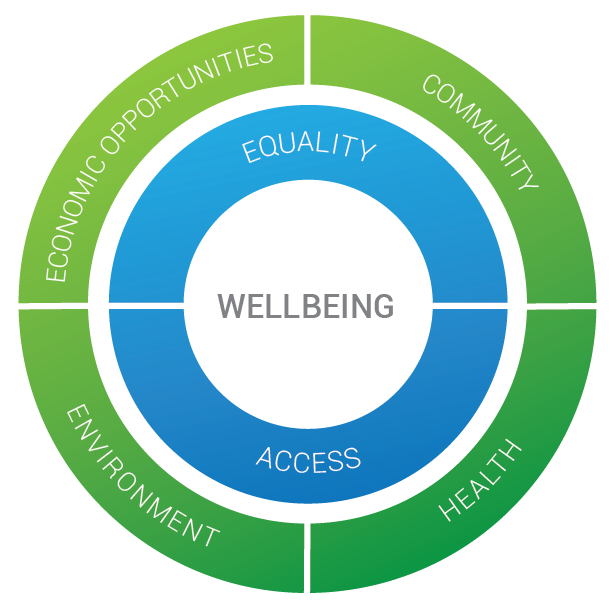Rural wellbeing: a framework and guide for policymakers
In his Budget this month – as part of the ‘Everywhere’ levelling up aspect of the economic plan – the Chancellor restated the commitment to ensuring the benefits of national success are “felt by people everywhere, whether in towns, cities, rural or coastal areas.”
How can we understand what supports and maintains wellbeing in different types of places – to ensure that people across the whole of the UK can lead happy and fulfilling lives?
We contributed to a project led by the Centre for Thriving Places, commissioned by the Department for Environment, Food and Rural Affairs (DEFRA), to understand what works to improve wellbeing in rural communities and support policymakers to use this in decision-making. As advisors on the project, we shared our evidence, evaluation and implementation expertise to help develop a new wellbeing framework for rural settings.
In this blog, we share key findings from the project’s final report and framework, along with further resources for measuring the impact of policy and practice on wellbeing.
This project aimed to support those working with and for rural communities, including DEFRA policymakers, to put wellbeing outcomes at the heart of their decision-making.
This included:
- Identifying the ‘domains’ or drivers of wellbeing ie the factors that matter most – through examining existing evidence and engaging with rural communities.
- Measuring how people in rural communities are doing across these domains – by reviewing both primary and secondary data sources.
- Developing a rural wellbeing evaluation toolkit or guidance, or identifying what would be needed to produce this.
Key findings
- Many drivers of wellbeing are shared between rural and urban settings. The basics of what we need to thrive are largely shared across different locations and settings.
- While the drivers of rural wellbeing may not be unique, there are specific influences across rural life that amplify common challenges or the impact of particular local conditions.
- Some UK rural places see the highest wellbeing in the country, others some of the lowest.
- There are evidence gaps, including a lack of research on the direct impact of key sustainability metrics on rural wellbeing; evidence on the drivers of wellbeing in the working age population in rural areas; education and learning, beyond formal education; and the impact of rural pollution on people’s wellbeing.
- Crucially, access to the things people need for wellbeing plays a vital role when considering wellbeing in a rural context (and equity of access both within rural and between urban and rural areas). It is both a key enabler and a regular barrier to wellbeing for rural communities.
- The report and framework suggests that access and equality are seen as lenses through which to understand wellbeing outcomes for policy.
The rural wellbeing framework
Through this research, seven elements were identified as key to improving wellbeing in rural communities. These seven areas form the core of the rural wellbeing framework:
- Equality, fairness and inclusiveness – Equal access to the things that matter most for our wellbeing.
- Economic opportunities – Including education opportunities, financial security and the specific impacts of rural economies and seasonal shifts on jobs, services and housing.
- Community – A strong community is a universal driver of wellbeing, and this was reflected throughout this research. This includes both geographic and social communities, combining social capital, sense of belonging, participation and having power and influence over our own lives.
- Environment – As expected, proximity to nature is a key driver in rural wellbeing; this domain also encompasses culture and heritage, as well as the built environment and safety.
- Health – Physical and mental health are key drivers of personal wellbeing in rural areas, as well as non-rural locations.
- Access – This includes both access to the other domains in the framework – i.e. access to services, jobs and support – plus access via key enablers such as transport and digital connectivity.
- Sustainability – Ensuring and taking account of the wellbeing of future generations.

Source: Defining and Measuring Rural Wellbeing, Centre for Thriving Places
You can find more information on the rural wellbeing framework in the full report, including an indicator bank to help policymakers across government take wellbeing outcomes into account. A rapid evidence assessment of what is known about wellbeing in rural communities for each of the drivers of wellbeing begins on page 32.
What you can do next
If you are working in policymaking or practice in a rural context, you can:
- Use the framework to create a shared understanding of the needs of your place and people living there now and in the future. Use this for community engagement, cross-sector planning, research partnerships and bid development.
- Use this alongside our report, Wellbeing evidence at the heart of policy and the Local needs for wellbeing data framework for further guidance on how to understand the needs of your local area.
- Read how Redcar and Cleveland Borough Council adapted the Local needs for wellbeing data framework to fit their needs as a coastal authority.
- Read the Chief Medical Officer Annual Report in 2021 on Coastal Communities which reflects some of the same issues from a health perspective.
- Read the HMT Green Book guidance on policymaking and appraisal. See the specific guidance on how wellbeing evidence can be used within the Green Book or sign up for one of our free training sessions with Pro Bono Economics and State of Life.
